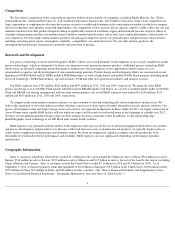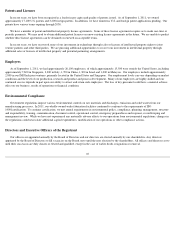Crucial 2011 Annual Report Download - page 20
Download and view the complete annual report
Please find page 20 of the 2011 Crucial annual report below. You can navigate through the pages in the report by either clicking on the pages listed below, or by using the keyword search tool below to find specific information within the annual report.
New product development may be unsuccessful.
We are developing new products that complement our traditional memory products or leverage their underlying design or process technology.
We have made significant investments in product and process technologies and anticipate expending significant resources for new semiconductor
product development over the next several years. The process to develop DRAM, NAND Flash, NOR Flash and certain specialty memory
products requires us to demonstrate advanced functionality and performance, many times well in advance of a planned ramp of production, in
order to secure design wins with our customers. We cannot assure you that our product development efforts will be successful, that we will be able
to cost-effectively manufacture new products, that we will be able to successfully market these products or that margins generated from sales of
these products will allow us to recover costs of development efforts.
Our net operating loss and tax credit carryforwards may be limited.
We have a valuation allowance against substantially all U.S. net deferred tax assets. As of September 1, 2011, our federal, state and foreign
net operating loss carryforwards were $2.9 billion, $2.0 billion and $529 million, respectively. If not utilized, substantially all of our federal and
state net operating loss carryforwards will expire in 2022 to 2031 and the foreign net operating loss carryforwards will begin to expire in 2015. As
of September 1, 2011, our federal and state tax credit carryforwards were $206 million and $215 million respectively. If not utilized, substantially
all of our federal and state tax credit carryforwards will expire in 2013 to 2031. As a consequence of prior business acquisitions, utilization of the
tax benefits for some of the tax carryforwards is subject to limitations imposed by Section 382 of the Internal Revenue Code and some portion or
all of these carryforwards may not be available to offset any future taxable income. The determination of these tax limitations is complex and
requires a significant amount of judgment by us with respect to analysis of past transactions.
Changes in foreign currency exchange rates could materially adversely affect our business, results of operations or financial condition.
Across our multi-national operations, there are transactions and balances denominated in currencies other than the U.S. dollar (our reporting
currency), primarily the Singapore dollar, euro and yen. We recorded net losses from changes in currency exchange rates of $ 6 million for 2011
and $23 million for 2010. To the extent our assets and liabilities denominated in currencies other than the U.S. dollar as of September 1, 2011 are
not hedged, we estimate that a 1% change in the exchange rate versus the U.S. dollar would expose us to foreign currency gains or losses of
approximately U.S. $ 2 million for the euro and U.S. $ 1 million for the yen and Singapore dollar. In the event that the U.S. dollar weakens
significantly compared to the Singapore dollar, euro or yen, our results of operations or financial condition may be adversely affected.
We face risks associated with our international sales and operations that could materially adversely affect our business, results of
operations or financial condition.
Sales to customers outside the United States approximated 84% of our consolidated net sales for 2011. In addition, a substantial portion of our
manufacturing operations are located outside the United States. In particular, a significant portion of our manufacturing operations are
concentrated in Singapore. Our international sales and operations are subject to a variety of risks, including:
These factors may materially adversely affect our business, results of operations or financial condition.
19
• export and import duties, changes to import and export regulations, and restrictions on the transfer of funds;
• compliance with U.S. and international laws involving international operations, including the Foreign Corrupt Practices Act, export
control laws and similar rules and regulations;
• political and economic instability;
• problems with the transportation or delivery of our products;
• issues arising from cultural or language differences and labor unrest;
• longer payment cycles and greater difficulty in collecting accounts receivable;
• compliance with trade, technical standards and other laws in a variety of jurisdictions;
• contractual and regulatory limitations on our ability to maintain flexibility with our staffing levels;
• disruptions to our manufacturing operations as a result of actions imposed by foreign governments;
• changes in economic policies of foreign governments; and
• difficulties in staffing and managing international operations.
























